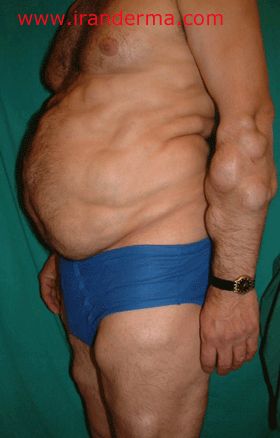IRANDERMA |
|
Quiz: February 2004 |
A 44-year-old male presented with multiple tumoral lesions on his extremities and trunk. The lesions were painless and started on his forearm since about 6 years before. He declares that there are similar lesions in his brother and sister. The diagnosis is ?
Diagnosis: Familial Multiple Lipomatosis (FML)
There are several forms lipomatosis. Familial multiple lipomatosis (FML) is transmitted in an autosomal dominant fashion and often becomes apparent by the third decade. It is characterized by slowly growing, usually asymptomatic, subcutaneous masses of various sizes in widespread distribution. It may be associated with hypertriglyceridemia, elevated high-density lipoprotein cholesterol, hyperuricemia, impaired glucose tolerance test and renal tubular acidosis.
Comment
by Dr. Mehrdad Mehavaran: Szeged
In general Multiple Lipomas may occur in groups of two to hundreds of confluent painless tumors of various sizes over any part of the body. These lesions are sometimes painful when growing rapidly. Three rare conditions are associated with multiple lipomas composed of mature fat cells, with onset in adult life:
1. Madelung's disease (benign asymmetric lipomatosis, multiple symetric lipomatosis, fetthals).
2. Dercum's Disease (adiposis dolorosa).
3. Familial Multiple Lipomatosis.
Diagnosis is Familial Multiple Lipomatosis. In this autosomal dominantly inherited syndrome, multiple asymptomatic lipomas of the forearms and thighs appear in the third decade of life. The shoulders and neck are spared, and lipomas are encapsulated and movable.
Comment
by Dr. Reza Shiari: Hokkaido
University Hospital- Sapporo
Familial multiple lipomatosis (FML) is an extremely rare hereditary disease. Inheritance is frequently by autosomal dminant transmission, although case with recessive inheritance have also been reported. The disorder usually occurs in third decade (middle-age).
The patients may have many of non-tender, slowly growing, asymptomatic, subcutaneous lipoms of various sizes and in widspread distribution. The lesions are often pronounced on the extremities specially forearms, and also on trunk.
The first case was reported in 1846 by Brodie. The disease usually dose not affected the daily life of FML victims, but they may experiance difficulty in performing everyday physical tasks if the lipomas are multiple and large.
ايران درما |
